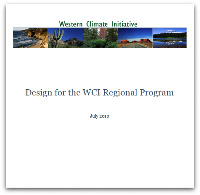
Western Climate Initiative plans cap-and-trade
August 6, 2010
By Western Climate Initiative
 |

|
Aug. 6, 2010 – On July 27, 2010, the partner jurisdictions of the Western Climate
Initiative (WCI) released a comprehensive strategy designed to reduce
climate-warming greenhouse gas (GHG) emissions, stimulate development of clean-energy
technologies, create green jobs, increase energy security and independence, and
protect public health.
The Design for the WCI Regional Program is the culmination of two years of work by seven U.S.
states and four Canadian provinces. However, only California, New Mexico,
British Columbia, Ontario, and Quebec are on track to adopt the regulations
required to implement the plan by 2012. Arizona, Utah, Washington, Oregon,
Montana, and Manitoba have delayed participation.
The plan’s objective is to reduce regional GHG emissions to 15 percent below 2005
levels by 2020. The regional goal will be reached by:
- Creating a market-based system that caps GHG emissions and uses tradable permits to
incentivize development of renewable and lower-polluting energy sources; - Encouraging GHG emissions reductions in industries not covered by the emissions cap, thus
reducing energy costs region wide, and; - Advancing policies that expand energy efficiency programs, reduce vehicle emissions,
encourage energy innovation in high-emitting industries, and help individuals
to transition to new jobs in the clean-energy economy.
In the absence of federal action to address climate change, the WCI partner
jurisdictions believe that it is important for state and provincial governments
to keep moving forward on the transition to a clean-energy economy and continue
to lead in demonstrated areas of expertise, including energy innovation,
efficiency, and conservation. A recently updated economic analysis by the partner jurisdictions of the WCI indicates that
their plan can achieve the regional GHG emissions reduction goal and realize a
cost savings of approximately US$100 billion by 2020. The economic analysis
underscores that mitigation of GHG emissions and the move to a clean-energy
economy is affordable and can be achieved without negatively affecting the
regional economy. This result is consistent with other recent state and federal
analyses of climate mitigation programs.
Regional cap-and-trade program
The central component of the WCI comprehensive strategy is a flexible,
market-based, regional cap-and-trade program that encourages the most
cost-effective, reliable alternatives to reduce GHG emissions. The WCI regional
cap-and-trade program will comprise the individual jurisdictions' cap-and-trade
programs implemented through state and provincial regulations. Each partner
jurisdiction implementing a cap-and-trade program will issue emission
allowances to meet its jurisdiction-specific emissions goal. The total number
of available allowances serves as the cap on emissions. A regional allowance
market is created by the partner jurisdictions accepting one another's allowances
for compliance. The allowances can be sold between and among covered entities
as well as by third parties.
This trading of emission allowances keeps costs low because it provides flexibility
in how and when reductions are made. For example, entities that reduce their
emissions below the number of allowances they hold can sell their excess
allowances or bank them for later use. Selling excess allowances allows
entities to recoup some of their emissions reduction costs, whereas banking
allowances will lessen future compliance costs.
Flexible, affordable program
The WCI program design recognizes that variations in jurisdictional authority,
regulatory procedures, and administrative requirements will result in different
approaches to implementation. Although not all WCI partner jurisdictions will
be implementing the cap-and-trade program when it begins in January 2012, those
expected to move ahead comprise approximately two-thirds of total emissions in
the WCI jurisdictions. This is a critical mass and a robust market for
achieving significant GHG emissions reductions.
The program design also reflects an understanding that potential future conditions
could lead to higher-than expected program costs. To ensure that the program is
not only affordable, but also supportive of economic growth and job creation,
the WCI partner jurisdictions are considering a number of options to address
unforeseen circumstances. These include an allowance reserve in the event of
high-price conditions, increased flexibility regarding compliance periods, and
special purpose mechanisms to address specific local conditions.
Next steps
Between now and the planned program start date of January 2012, the WCI partner
jurisdictions will address remaining program design issues and take the steps
necessary to make regional trading operational. Also, they will expand their
efforts to develop and implement other core policies and programs to increase
energy efficiency and fuel diversification to reduce GHG emissions.
Print this page